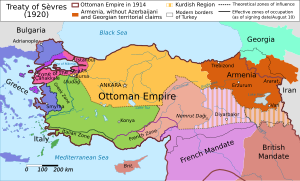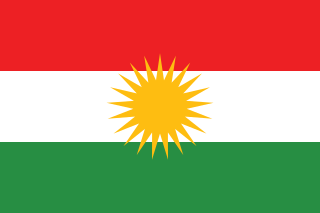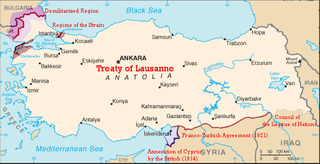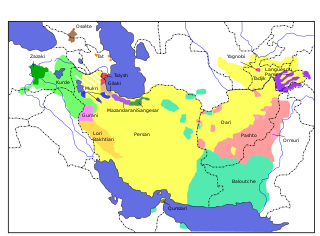
Secession in Turkey is a phenomenon caused by the desire of a number of minorities living in Turkey to secede and form independent national states. [1] [2]

Secession in Turkey is a phenomenon caused by the desire of a number of minorities living in Turkey to secede and form independent national states. [1] [2]
At the beginning of the 21st century, the Kurds remain the largest of the groups without their own statehood. The Treaty of Sèvres between Ottoman Empire and Triple Entente (1920) provided for the creation of an independent Kurdistan. However, this agreement never entered into force and was cancelled after the signing of the Treaty of Lausanne (1923). In the 1920s and 1930s, Kurds several times unsuccessfully rebelled against the Turkish authorities.
In August 1984, the Kurdistan Workers' Party (PKK) declared war on the Turkish authorities, which continues today. Until 1993, the PKK made the most radical demand – the proclamation of a single and independent Kurdistan, uniting the Kurdish territories that are now part of the state borders of Turkey, Iran, Iraq and Syria.
Since 1999, the PKK has put forward requirements that are close and understandable to the bulk of the Kurdish population, namely: granting autonomy, preserving national identity, practical equalization of Kurds in rights with the Turks, opening of national schools and introduction of Kurdish TV and radio broadcasting.


Western Armenia (Western Armenian: Արեւմտեան Հայաստան, Arevmdian Hayasdan), located in Western Asia, is a term used to refer to eastern parts of Turkey (formerly the Ottoman Empire) that were part of the historical homeland of the Armenians. [10] Western Armenia, also referred to as Byzantine Armenia, emerged following the division of Greater Armenia between the Byzantine Empire (Western Armenia) and Sassanid Persia (Eastern Armenia) in 387 AD.
The area was conquered by the Ottomans in the 16th century during the Ottoman–Safavid War (1532–1555) against their Iranian Safavid arch-rivals. Being passed on from the former to the latter, Ottoman rule over the region became only decisive after the Ottoman–Safavid War of 1623–1639. [11] The area then became known as Turkish Armenia or Ottoman Armenia. During the 19th century, the Russian Empire conquered all of Eastern Armenia from Iran, [12] and also some parts of Turkish Armenia, such as Kars. The region's Armenian population was affected during the Hamidian massacres.
The Armenians living in their ancestral lands were exterminated or deported by Ottoman forces during the Armenian genocide and over the following years. The systematic destruction of Armenian cultural heritage, which had endured over 4000 years, [13] [14] is considered an example of cultural genocide. [15] [16]
Only assimilated and crypto-Armenians live in the area today, and some irredentist Armenians claim it as part of United Armenia. The most notable political party with these views is the Armenian Revolutionary Federation.

Kurds or Kurdish people are an Iranian ethnic group native to the mountainous region of Kurdistan in Western Asia, which spans southeastern Turkey, northwestern Iran, northern Iraq, and northern Syria. There are exclaves of Kurds in Central Anatolia, Khorasan, and the Caucasus, as well as significant Kurdish diaspora communities in the cities of western Turkey and Western Europe. The Kurdish population is estimated to be between 30 and 45 million.

Demographic features of the population of Turkey include population density, ethnicity, education level, health of the populace, economic status, religious affiliations and other aspects of the population.

The Treaty of Lausanne is a peace treaty negotiated during the Lausanne Conference of 1922–23 and signed in the Palais de Rumine in Lausanne, Switzerland, on 24 July 1923. The treaty officially resolved the conflict that had initially arisen between the Ottoman Empire and the Allied French Republic, British Empire, Kingdom of Italy, Empire of Japan, Kingdom of Greece, Kingdom of Serbia, and the Kingdom of Romania since the outset of World War I. The original text of the treaty is in French. It emerged as a second attempt at peace after the failed and unratified Treaty of Sèvres, which had sought to partition Ottoman territories. The earlier treaty, signed in 1920, was later rejected by the Turkish National Movement which actively opposed its terms. As a result of the Greco-Turkish War, Izmir was reclaimed, and the Armistice of Mudanya was signed in October 1922. This armistice provided for the exchange of Greek-Turkish populations and allowed unrestricted civilian, non-military passage through the Turkish Straits.

The Kurds are an Iranian ethnic group in the Middle East. They have historically inhabited the mountainous areas to the south of Lake Van and Lake Urmia, a geographical area collectively referred to as Kurdistan. Most Kurds speak Northern Kurdish Kurmanji Kurdish (Kurmanji) and Central Kurdish (Sorani).

The Treaty of Sèvres was a 1920 treaty signed between the Allies of World War I and the Ottoman Empire. The treaty ceded large parts of Ottoman territory to France, the United Kingdom, Greece and Italy, as well as creating large occupation zones within the Ottoman Empire. It was one of a series of treaties that the Central Powers signed with the Allied Powers after their defeat in World War I. Hostilities had already ended with the Armistice of Mudros.

The Zazas are a people in eastern Turkey who traditionally speak the Zaza language, a western Iranian language written in the Latin script. Their heartland consists of Tunceli and Bingöl provinces and parts of Elazığ, Erzincan and Diyarbakır provinces. Zazas generally consider themselves Kurds, and are often described as Zaza Kurds by scholars.

Western Armenia is a term to refer to the western parts of the Armenian highlands located within Turkey that comprise the historical homeland of the Armenians. Western Armenia, also referred to as Byzantine Armenia, emerged following the division of Greater Armenia between the Byzantine Empire and Sassanid Persia in AD 387. Since the Armenian genocide, the Armenian diaspora as well as Armenians indigenous to modern Turkey have sought political representation in Western Armenia or reunification with the Republic of Armenia.

The Kurds are the largest ethnic minority in Turkey. According to various estimates, they compose between 15% and 20% of the population of Turkey. There are Kurds living in various provinces of Turkey, but they are primarily concentrated in the east and southeast of the country within the region viewed by Kurds as Turkish Kurdistan.
Turkification, Turkization, or Turkicization describes a shift whereby populations or places received or adopted Turkic attributes such as culture, language, history, or ethnicity. However, often this term is more narrowly applied to mean specifically Turkish rather than merely Turkic, therefore referring to the Ottoman Empire, and the Turkish nationalist policies of the Republic of Turkey toward ethnic minorities in Turkey. As the Turkic states developed and grew, there were many instances of this cultural shift.

Armenian–Kurdish relations covers the historical relations between the Kurds and the Armenians.

The Koçgiri rebellion was a Kurdish uprising, that began in the overwhelmingly militant Koçgiri region in present-day eastern Sivas Province in February 1921. The rebellion was initially Alevi, but it succeeded in gathering support from nearby Sunni tribes. The tribal leaders had a close relationship with the Society for the Rise of Kurdistan (SAK). The rebellion was defeated in June 1921.
Kurds have had a long history of discrimination perpetrated against them by the Turkish government. Massacres have periodically occurred against the Kurds since the establishment of the Republic of Turkey in 1923. Among the most significant is the massacre that happened during the Dersim rebellion, when 13,160 civilians were killed by the Turkish Army and 11,818 people were sent into exile. According to McDowall, 40,000 people were killed. The Zilan massacre of 1930 was a massacre of Kurdish residents of Turkey during the Ararat rebellion, in which 5,000 to 47,000 were killed.
Kurdish nationalist uprisings have periodically occurred in Turkey, beginning with the Turkish War of Independence and the consequent transition from the Ottoman Empire to the modern Turkish state and continuing to the present day with the current PKK–Turkey conflict.

The History of the Shī‘ah Imāmate Alevī Ṭarīqah or The History of the Alevism is that of a community of Muslims of Anatolia and neighbouring regions.

Kurdish nationalism is a nationalist political movement which asserts that Kurds are a nation and espouses the creation of an independent Kurdistan from Iran, Iraq, Syria, and Turkey.

The nationalist movement among the Kurdish people first emerged in the late 19th century with an uprising in 1880 led by Sheik Ubeydullah. Many Kurds worked with other opponents of the Ottoman regime within the Committee of Union and Progress (CUP). A growth in ethnic consciousness at the start of the 20th century was spearheaded by the Society for the Elevation of Kurdistan. Some Kurdish nationalist groups agitated for secession, others for autonomy.
The Sèvres Syndrome refers to a popular belief in Turkey that dangerous internal and external enemies, especially the West, are "conspiring to weaken and carve up the Turkish Republic." The term originates from the Treaty of Sèvres of the 1920s, which partitioned the Ottoman Empire among Armenia, Greece, Britain, France, and Italy, leaving a small unaffected area around Ankara under Turkish rule; however, it was never implemented since it was left unratified by the Ottoman Parliament and due to Turkish victory on all fronts during the subsequent Turkish War of Independence. Turkish historian Taner Akçam describes this attitude as an ongoing perception that "there are forces which continually seek to disperse and destroy us, and it is necessary to defend the state against this danger."

Syrian Kurdistan is a region in northern Syria where Kurds form the majority. It is surrounding three noncontiguous enclaves along the Turkish and Iraqi borders: Afrin in the northwest, Kobani in the north, and Jazira in the northeast. Syrian Kurdistan is often called Western Kurdistan or Rojava, one of the four "Lesser Kurdistans" that comprise "Greater Kurdistan", alongside Iranian Kurdistan, Turkish Kurdistan, and Iraqi Kurdistan.

During World War I, several Kurdish rebellions took place within the Ottoman Empire.

Ottoman Kurds were ethnic Kurds who lived in the Ottoman Empire. At its peak, the Ottoman Empire ruled Turkish Kurdistan, Iraqi Kurdistan, Syrian Kurdistan, and a small part of Iranian Kurdistan.
This date is important, for it marks the beginning of the Armenian Genocide, which destroyed the over two-thousand-year Armenian presence in historical, Western Armenia.